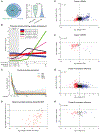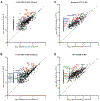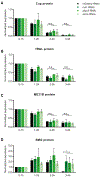Precise Temporal Regulation of Post-transcriptional Repressors Is Required for an Orderly Drosophila Maternal-to-Zygotic Transition
- PMID: 32579915
- PMCID: PMC7372737
- DOI: 10.1016/j.celrep.2020.107783
Precise Temporal Regulation of Post-transcriptional Repressors Is Required for an Orderly Drosophila Maternal-to-Zygotic Transition
Abstract
In animal embryos, the maternal-to-zygotic transition (MZT) hands developmental control from maternal to zygotic gene products. We show that the maternal proteome represents more than half of the protein-coding capacity of Drosophila melanogaster's genome, and that 2% of this proteome is rapidly degraded during the MZT. Cleared proteins include the post-transcriptional repressors Cup, Trailer hitch (TRAL), Maternal expression at 31B (ME31B), and Smaug (SMG). Although the ubiquitin-proteasome system is necessary for clearance of these repressors, distinct E3 ligase complexes target them: the C-terminal to Lis1 Homology (CTLH) complex targets Cup, TRAL, and ME31B for degradation early in the MZT and the Skp/Cullin/F-box-containing (SCF) complex targets SMG at the end of the MZT. Deleting the C-terminal 233 amino acids of SMG abrogates F-box protein interaction and confers immunity to degradation. Persistent SMG downregulates zygotic re-expression of mRNAs whose maternal contribution is degraded by SMG. Thus, clearance of SMG permits an orderly MZT.
Keywords: Cup; ME31B; RNA-binding; Smaug; Trailer hitch; embryogenesis; proteome; ubiquitin ligase.
Copyright © 2020 The Author(s). Published by Elsevier Inc. All rights reserved.
Conflict of interest statement
Declaration of Interests The authors declare no competing interests.
Figures







References
-
- Aanes H, Collas P, and Aleström P (2014). Transcriptome dynamics and diversity in the early zebrafish embryo. Brief. Funct. Genomics 13, 95–105. - PubMed
-
- Aviv T, Lin Z, Lau S, Rendl LM, Sicheri F, and Smibert CA (2003). The RNA-binding SAM domain of Smaug defines a new family of post-transcriptional regulators. Nat. Struct. Biol 10, 614–621. - PubMed
-
- Aviv T, Lin Z, Ben-Ari G, Smibert CA, and Sicheri F (2006). Sequence-specific recognition of RNA hairpins by the SAM domain of Vts1p. Nat. Struct. Mol. Biol 13, 168–176. - PubMed
-
- Bailey TL, and Elkan C (1994). Fitting a mixture model by expectation maximization to discover motifs in biopolymers. Proc. Int. Conf. Intell. Syst. Mol. Biol 2, 28–36. - PubMed
-
- Baltz AG, Munschauer M, Schwanhäusser B, Vasile A, Murakawa Y, Schueler M, Youngs N, Penfold-Brown D, Drew K, Milek M, et al. (2012). The mRNA-bound proteome and its global occupancy profile on protein-coding transcripts. Mol. Cell 46, 674–690. - PubMed
Publication types
MeSH terms
Substances
Grants and funding
LinkOut - more resources
Full Text Sources
Molecular Biology Databases
Miscellaneous

